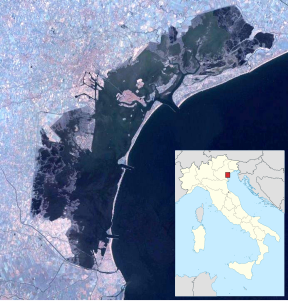Santo Spirito (island)
| Santo Spirito | ||
|---|---|---|
| Waters | Venice lagoon | |
| Geographical location | 45 ° 24 ′ 1 ″ N , 12 ° 20 ′ 3 ″ E | |
|
|
||
| surface | 2.38 ha | |
| Residents | uninhabited | |
Santo Spirito is an island in the Venice lagoon . It is located south of Venice, between the islands of San Clemente and Poveglia . The area of the island is 2.38 hectares , with a length of 200 meters and a width of 150 meters.
During the Chioggia War between Venice and Genoa in 1379, the Genoese fleet occupied Chioggia, and in December 1379 some of the troops who stayed until February 1380 entered the monastery. The monastery was shelled and when the Genoese withdrew, the Brondolo monastery was demolished. The monks there received from the Senate the Santo Spirito monastery on the island of the same name, which had been abandoned by the Augustinian choirs. This was in 1409 by the Senate and Pope Gregory XII. approved. However, the monastery soon disappeared. It was no longer mentioned when the Italian Cistercian Congregation was founded in 1497.
Today the island is uninhabited, in the past there was a church of Sansovino. Monks lived on the island until 1806, after which they left because Napoleon caused them too many difficulties. After the monks left, the French garrison built accommodation for soldiers and a number of storage sheds, not without tearing down a number of houses beforehand.
Today the island makes a neglected and dilapidated impression, since nobody tried to revitalize the island from the beginning of the second half of the 20th century.
The paintings by Palma il Vecchio and Tizian , once in the church of Santo Spirito , were brought to the city of Venice.
Web links
Remarks
- ↑ Sabine Arend (Ed.): Diversity and Topicality of the Middle Ages: Festschrift for Wolfgang Petke for his 65th birthday , Verlag für Regionalgeschichte, 2006, p. 119.

